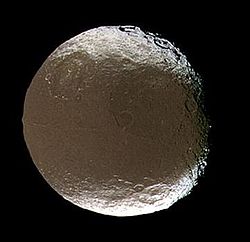Iapetus (moon)

Iapetus is a large moon of Saturn. It was discovered by Giovanni Domenico Cassini in 1671.[1]
Iapetus is unusual: one side is very bright and the other side is very dark. This is because one half of the moon is covered in ice and the other side is coated in black, dusty carbon deposits.[1] When Cassini observed the moon, he could only see the moon on one side of Saturn. He concluded that the moon is darker on side than the other, and it was confirmed by the Voyager 1 spacecraft. Iapetus also has an equatorial ridge discovered by the Cassini-Huygens spacecraft on 31 December 2004. Iapetus has a slow rotation rate, taking 79 Earth days for a rotation.[1] Another observation that has puzzled scientists is how it has a mountain range across its equator, giving it the shape of a walnut.
Iapetus (moon) Media
John Herschel, the astronomer who suggested that the moons of Saturn be named after the Titans and Giants
Size comparison between Iapetus (lower left), the Moon (upper left) and Earth
The bright regions of Iapetus. Roncevaux Terra is at the top (north); while Saragossa Terra with its prominent basin Engelier, Iapetus's second largest, is at the bottom.
References
- ↑ 1.0 1.1 1.2 Cox, Brian; Cohen, Andrew (2010). Wonders of the Solar System. HarperCollins. p. 94-95. ISBN 9780007386901.








